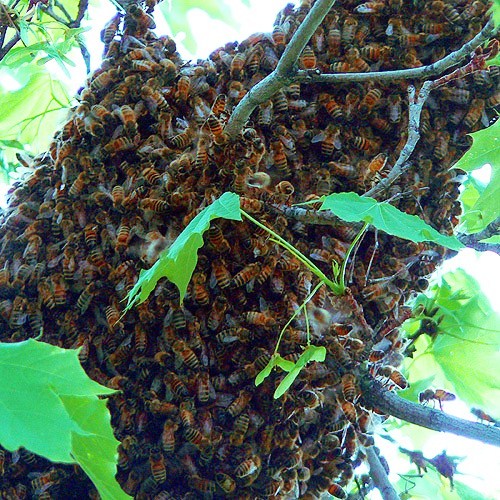
A European Honey Bee swarm taking temporary refuge on a tree limb before finding a new home for their expanding colony.
Honey bee swarms are a normal sign of healthy honey bee colonies. Two types of reproduction occur with honey bees. First, there is individual (biological) reproduction from eggs laid by the queen. Second, there is colony level reproduction, or swarming. When a colony swarms, it splits into two independent colonies.
Swarming peaks in spring and early summer. During spring the overwintered queen increases egg production, hive populations grow rapidly and the brood nest becomes congested with bees. Queens affect a colony not only by producing eggs, but by producing pheromone that, among other things, informs workers of the queen’s presence. Aging queens produce less pheromone, even though their egg production may still be high. If workers do not detect enough queen pheromones, they begin rearing new queens.
A swarm is a dramatic sight; up to 40,000 bees including the old queen fly from the hive, swirl in the air, gradually congregate on some branch or other object, and finally form a large hanging cluster. Scout bees seek a permanent nest site and eventually the swarm relocates to the new nest, usually a hollow tree.
From the bee’s point of view, swarming is beneficial because it propagates the species. From a beekeeper’s point of view, swarming should be avoided at all costs. A swarm drains a colony of over 60 percent of its bees, right when the beekeeper wants them the most. If honey production is your goal, don’t let your colonies swarm.
Proactive beekeeping practices to alter colonies in response to potential swarming behavior must be undertaken regularly during the swarming season. Some measures that may be used to decrease swarming are as follows:
- Clip ½ of one forewing off the queen.
- Remove frames of bees/brood to add to weaker colonies or use to create nucs.
- Requeen colonies yearly.
- Cut queen cells from colonies every seven to nine days beginning four weeks prior to the primary nectar flow and throughout.
- Provide adequate empty combs in the brood nest and/or add supers to colonies to reduce colony congestion.
- Equalize strong and week colonies prior to the primary nectar flow.
Information for this article was provided by University of Florida IFAS Extension Apiculturist, Dr. Jamie Ellis, as well as the following UF/IFAS publication: Swarm Control for Managed Beehives
- Things to Consider When Moving Honey Bee Hives - May 29, 2015
- Honeybees are Valuable Pollinators - December 19, 2014
- Manage Honey Bees Now to Prepare for Next Year’s Nectar Flow - August 1, 2014
